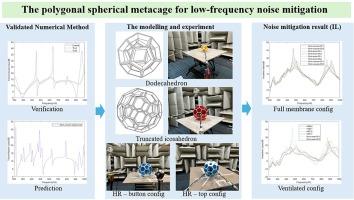用于降低低频噪声的球形外壳
IF 3.4
2区 物理与天体物理
Q1 ACOUSTICS
引用次数: 0
摘要
低频噪声衰减是有效噪声控制的关键,本研究提出了一种创新的球形元天线。metacage由倾斜边缘的膜板式组件组成,创造了一个由轻质,高效的声学超材料完全覆盖的结构,专门针对低频噪声。通过在设计中使用彩色PVC片材,增强了美学吸引力。通过实验验证的比例数值模拟,该研究证实了元腔通过弹性膜形成的耦合亥姆霍兹谐振腔的共振来减轻低频噪声的能力。球形结构优化了隔音罩,最大限度地提高了隔音效果。该设计实现了双峰隔音,并在1000 Hz以下建立了宽的带隙,其特点是高插入损耗。此外,用可调节的通风亥姆霍兹谐振器组件替代五个膜组件,可以在两个不同的频率区域保持有效的带隙。这些通风部件通过利用侧腔的共振来衰减噪声,在侧腔中,声波的通过会破坏孔中的小气团。这种安排扩大了有效频率范围,同时最大限度地减少了内腔共振的放大效应。因此,提议的重新配置的结构为低频噪声衰减提供了一个有希望的解决方案,同时也满足了通风要求。本文章由计算机程序翻译,如有差异,请以英文原文为准。

Spherical metacage for low-frequency noise reduction
Low-frequency noise attenuation is crucial for effective noise control, and this study presents an innovative spherical metacage designed for this purpose. The metacage is composed of membrane plate-type components with inclined edges, creating a structure fully covered by lightweight, efficient acoustical metamaterials specifically targeting low-frequency noise. Aesthetic appeal is enhanced by the use of colored PVC sheets in the design. Through experimentally validated scaled numerical simulations, the study confirms the metacage's ability to mitigate low-frequency noise via the resonance of coupled Helmholtz resonator cavities formed by elastic membranes. The spherical configuration optimizes sonic enclosure to maximize sound insulation. The design achieves dual-peak sound insulation and establishes a wide bandgap below 1000 Hz, marked by high insertion loss. Additionally, the substitution of five membrane components with adjustable, ventilated Helmholtz resonator components preserves an effective bandgap across two different frequency regions. These ventilated components attenuate noise by utilizing the resonance of side cavities, where the passage of sound waves disrupts small air masses at the orifices. This arrangement expands the effective frequency range while minimizing the amplification effects of internal cavity resonance. The proposed reconfigured structure thus provides a promising solution for low-frequency noise attenuation, while also meeting ventilation requirements.
求助全文
通过发布文献求助,成功后即可免费获取论文全文。
去求助
来源期刊

Applied Acoustics
物理-声学
CiteScore
7.40
自引率
11.80%
发文量
618
审稿时长
7.5 months
期刊介绍:
Since its launch in 1968, Applied Acoustics has been publishing high quality research papers providing state-of-the-art coverage of research findings for engineers and scientists involved in applications of acoustics in the widest sense.
Applied Acoustics looks not only at recent developments in the understanding of acoustics but also at ways of exploiting that understanding. The Journal aims to encourage the exchange of practical experience through publication and in so doing creates a fund of technological information that can be used for solving related problems. The presentation of information in graphical or tabular form is especially encouraged. If a report of a mathematical development is a necessary part of a paper it is important to ensure that it is there only as an integral part of a practical solution to a problem and is supported by data. Applied Acoustics encourages the exchange of practical experience in the following ways: • Complete Papers • Short Technical Notes • Review Articles; and thereby provides a wealth of technological information that can be used to solve related problems.
Manuscripts that address all fields of applications of acoustics ranging from medicine and NDT to the environment and buildings are welcome.
 求助内容:
求助内容: 应助结果提醒方式:
应助结果提醒方式:


